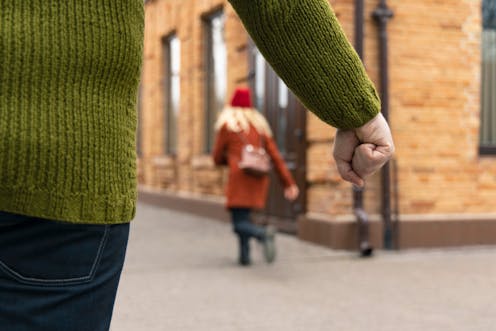Men are more likely to commit violent crimes. Why is this so and how do we change it?
- Written by Rick Sarre, Emeritus Professor of Law and Criminal Justice, University of South Australia

Criminology is the study of individual and social factors associated with crime and the people who perpetrate it. One of the discipline’s well-established truths is that men commit violent and sexual offences at far higher rates than women.
Men are also the most likely victims of physical violence across the board, but women are far more likely than men to be victims of sexual, familial and domestic violence.
Rates of imprisonment give us tangible evidence of this gender imbalance.
Across Australia, only about 8% of prisoners are women. While prison population figures provide only a very rough guide to criminal behaviour, we can safely assert that men perpetrate the vast majority of criminal conduct, and certainly violent conduct.
What does the research tell us about the patterns behind this alarming fact?
In the early days of criminological enquiry, much attention was given to the Y chromosome – the determinant of male sex organs. This line of research, referred to broadly as biological positivism, gave rise to explanations that “men can’t help themselves”. Fortunately, these theorists hold very little sway in criminological circles today.
Read more: 'Cultural misogyny' and why men's aggression to women is so often expressed through sex
More contemporary attention is given to factors associated with the societies in which we live.
Social learning theory posits that men are more likely than women to associate with antisocial peers.
Other scholars are interested in the way in which key life experiences influence the propensity to commit crime. Known as developmental and life course criminology, it suggests the causes of crime are a result of a linking of individual characteristics, such as impulsiveness, with a person’s environmental factors such as their family, schooling, religion, neighbourhood and the way they were parented, including any exposure to neglect and maltreatment. Renowned criminologist David Farrington has suggested these factors play out differently for males and females.
Into the sociological frame, too, comes strain theory, which proposes that difficult circumstances or life stresses can produce anger and frustration that may lead to violence. The gender divide is explained by the evidence that men are likely to react violently to such strains. Women, according to this theory, are more likely to internalise their responses.
Edgework theory pursues the idea that men are more likely than women to engage in risk-taking behaviour, even to the edge of acceptable conduct. Men in the criminal justice system are best described, on this view, as “risky thrill-seekers” while women caught up in the same system are more likely to be described as “at risk”.
The science of psychology, too, plays an important role here. Psychological studies suggest gender role identification − internalised characteristics culturally regarded as appropriate behaviour for men and women − rather than gender itself is crucial to the experience of anger, its expression and control.
How are these gender divides created and shaped? Criminologists such as Ngaire Naffine have offered the view that there has always been an entrenched belief in the “natural” order of things, which associates masculinity with dominance and status. In this view, individuals construct their beliefs according to their class, ethnicity and sexuality, but the result is always a reinforcement of dominant patterns of masculinity. One can observe these patterns in competition for status, bravado among peers, the drive for power and control, shamelessness, and a lack of concern for others.
Women, by contrast, are less likely to display these traits because society (including the criminal justice system) has positioned them as needing greater protection, with consequent patronising benevolence.
In summary, men disproportionately exhibit far more anti-social behaviour than women. When it comes to sexual crimes, men are far more likely to commit them, and women are far more likely to be the victims. The easy cultural dismissal that “boys will be boys” simply doesn’t stand up to scrutiny and is actively doing damage.
So how best can we respond to the problem of violence perpetrated by men?
Law reform is necessary to ensure the practice of law is in line with prevailing social norms and priorities. This has certainly not always been the case. For example, until the 1970s there was no such thing, legally, as rape in marriage. Even in the first iteration of reform to the law, a prosecution could only proceed if there was evidence of actual bodily harm to the victim.
Read more: Where do we go from here with the allegations about Christian Porter?
There have been other pleasing law reforms too. Today, in many jurisdictions, police provide victim assistance services, prosecution counsel are trained in handling traumatised clients, limits have been placed on cross-examination practices, and directions to juries do not carry the same cautions regarding corroborative evidence that were standard a decade ago.
Legal change is necessary, but it is not enough. For the most part, the law comes in only after the damage has been done.
Of greater importance in the drive for change is the value that societies must place on teaching all men to respect and value the worth of all people, regardless of gender, race, or creed. When that is socially learned, and flawed expectations of masculinity are put to one side, men will be less likely to engage in risky behaviours and internalise gendered expectations. They will also be more likely to draw on pro-social coping mechanisms when under stress, and more likely to reject the notion that masculinity must identify with power, control, shamelessness and independence.
Creating conditions beyond individual responses is important too. Mass movements and marches like the ones witnessed this month have provided great impetus to the social and political conditions required for positive change.
Authors: Rick Sarre, Emeritus Professor of Law and Criminal Justice, University of South Australia



















